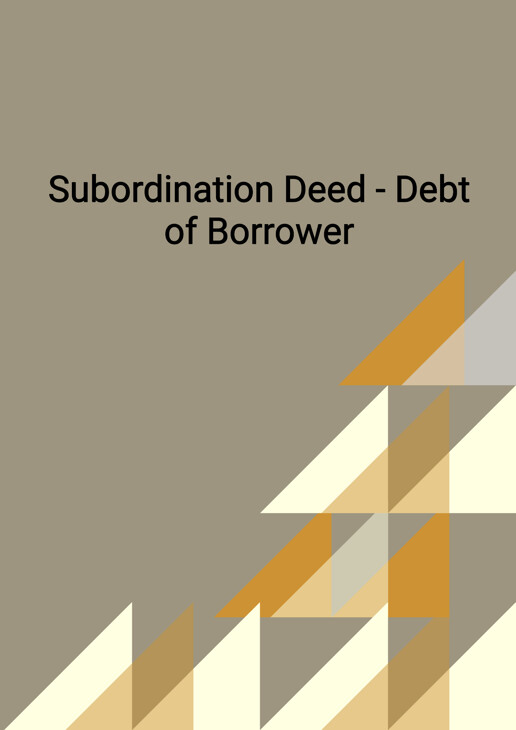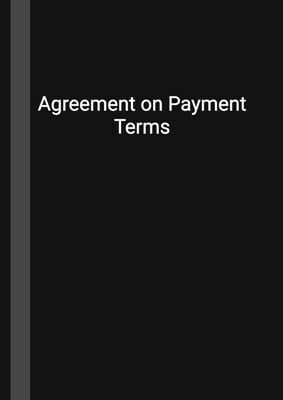How to Tailor the Document for Your Need?
01
Create Document
Fill in the details of the parties. You can click the "Fill with Member’s Information" button to complete it with information saved to your account.
02
Fill Information
Please fill in any additional information by following the step-by-step guide on the left hand side of the preview document and click the "Next" button.
03
Get Document
When you are done, click the "Get Document" button and you can download the document in Word or PDF format.
04
Review Document
The document should be signed by the authorised signatory (or directors of a company) and witnessed to complete the formality.
Document Preview
Document Description
This document is a Subordination Deed that is made between the subordinated lenders, the agent for the benefit of the finance parties, and the borrower. The purpose of this deed is to subordinate the subordinated debt to the senior debt, meaning that the subordinated lenders agree that the senior debt will be paid in full before any payment is made on the subordinated debt. This deed is made in connection with the finance documents.
The deed begins with an interpretation section, defining various terms used throughout the document. It clarifies that the subordinated debt refers to the indebtedness of the borrower to the subordinated lenders, while the senior debt refers to the moneys, debts, and liabilities due to any finance party under the finance documents.
The deed then sets out the subordination provisions, stating that each subordinated lender covenants to subordinate the subordinated debt to the senior debt. The subordinated debt is not due or payable until the senior debt discharge date, except for permitted payments or after the occurrence of certain events described in the deed.
The borrower also has undertakings, including not making any payment or distribution in respect of the subordinated debt, not creating any security or guarantee for the subordinated debt, and not amending any provision of the subordinated finance documents without the consent of the agent.
The subordinated lenders have similar undertakings, including not demanding or receiving payment or any distribution in respect of the subordinated debt, not exercising any set-off against the subordinated debt, and not amending any provision of the subordinated finance documents without the consent of the agent.
The deed also addresses the treatment of permitted payments, suspension of permitted payments in the event of an event of default, and the turnover of non-permitted payments. It sets out the subordination on insolvency provisions, including the filing of claims and the distribution of payments.
Other provisions of the deed cover voting rights, consents, representations and warranties, information sharing, protection of subordination, order of distributions, power of attorney, changes to the parties, expenses, notices, counterparts, governing law, and jurisdiction.
This Subordination Deed is a legally binding agreement that ensures the subordination of the subordinated debt to the senior debt, providing clarity and protection for all parties involved.
How to use this document?
To use this Subordination Deed, follow these steps:
1. Review the definitions: Familiarize yourself with the definitions provided in the interpretation section to understand the terms used throughout the document.
2. Understand the subordination provisions: Read and understand the subordination provisions, which state that the subordinated debt is subordinated to the senior debt and is not due or payable until the senior debt discharge date.
3. Review the undertakings: Take note of the undertakings of the borrower and the subordinated lenders, which include restrictions on payments, set-offs, amendments, and other actions that may affect the subordination.
4. Familiarize yourself with the permitted payments and suspension provisions: Understand the conditions under which the borrower may make permitted payments and the circumstances in which the agent may suspend permitted payments.
5. Learn about the turnover of non-permitted payments: Understand the obligations of the subordinated lenders to notify the agent of any non-permitted payments received and to hold such payments on trust for the finance parties.
6. Review the subordination on insolvency provisions: Familiarize yourself with the provisions relating to the filing of claims, distributions, and the treatment of payments in the event of insolvency.
7. Understand the voting rights: Take note of the agent's authority to exercise voting rights on behalf of the subordinated lenders and the requirement for the subordinated lenders to comply with the agent's directions.
8. Review the representations and warranties: Understand the representations and warranties made by the borrower and the subordinated lenders regarding their status, binding obligations, power and authority, and other matters.
9. Ensure compliance with information sharing requirements: Be aware of the obligations to notify the agent of any events of default or potential events of default and to provide details of the subordinated debt.
10. Understand the protection of subordination provisions: Take note of the provisions that preserve the subordination in various circumstances and waive certain rights in favor of the subordinated lenders and the borrower.
11. Learn about the order of distributions: Understand the order in which amounts received or recovered by the agent or any delegate will be applied, including the payment of costs, losses, liabilities, and expenses, the senior debt, and any surplus.
12. Be aware of the power of attorney: Understand the appointment of the agent as the attorney for the subordinated lenders and the borrower and the scope of the agent's powers.
13. Review the provisions regarding changes to the parties: Understand the restrictions on the assignment or transfer of rights and obligations under the deed and the requirements for any such assignment or transfer.
14. Be aware of the provisions regarding expenses, notices, counterparts, governing law, and jurisdiction: Familiarize yourself with the provisions relating to transaction expenses, stamp duty, interest, notices, counterparts, governing law, and jurisdiction.
15. Execute the deed: Once you have reviewed and understood the provisions of the deed, execute the document by signing and delivering it as a deed.
Please note that this guidance is for informational purposes only and does not constitute legal advice. It is recommended to consult with a legal professional to ensure compliance with applicable laws and regulations.
Not the right document?
Don’t worry, we have thousands of documents for you to choose from:















